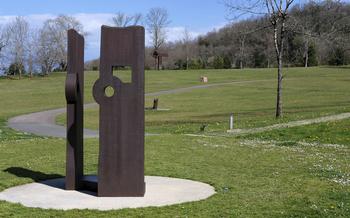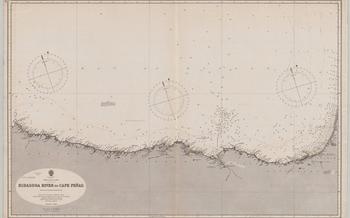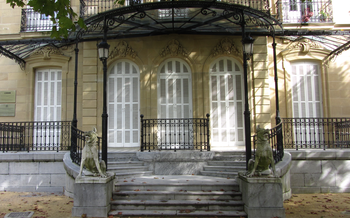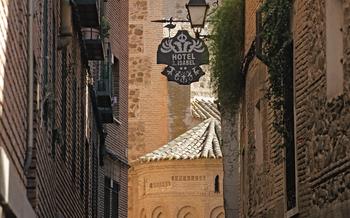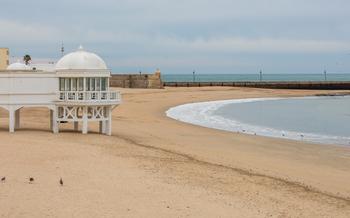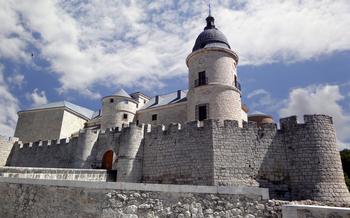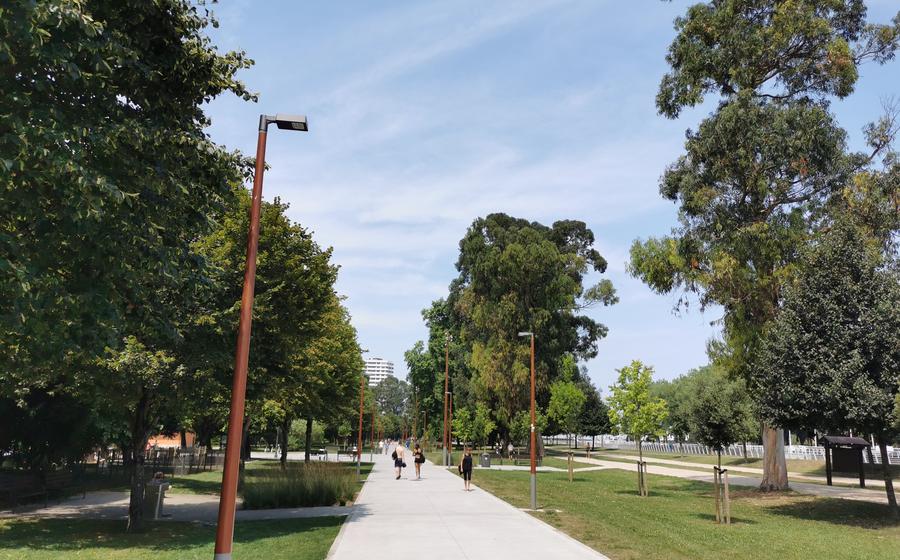
Isabel la Católica Park
- El parque de Isabel la Católica
- The Sculptures
- The Rose Garden
- The Pond
- The Playground
- The Café
- The Events
- Guided Tours
- The Accessibility
- The Sustainability
- The Future
- The Legends
- The Myths:
- Insider Tip:
El parque de Isabel la Católica
In the heart of Gijón, a vibrant coastal city in northern Spain, lies a verdant sanctuary known as El Parque de Isabel la Católica. This sprawling green haven, named after Queen Isabella I of Castile, holds a rich history that intertwines with the cultural fabric of the city. Its genesis can be traced back to the late 19th century when Gijón underwent a remarkable transformation, transitioning from a humble fishing village to a thriving industrial hub. As the city's population surged, the need for green spaces became increasingly apparent, leading to the creation of this magnificent park.
El Parque de Isabel la Católica was meticulously designed by renowned landscape architects who sought to create a harmonious blend of natural beauty and urban functionality. The park encompasses a vast expanse of verdant lawns, meticulously manicured flower beds, and towering trees that provide shade and tranquility. Its intricate network of pathways invites visitors to embark on leisurely strolls, while serene ponds and fountains add a touch of tranquility to the atmosphere.
The park's layout reflects the prevailing aesthetic sensibilities of the time, characterized by a blend of Romantic and Modernist influences. This harmonious fusion manifests itself in the park's elegant promenades, adorned with intricate tile work and elaborate lampposts, as well as in the graceful curves of its bridges and gazebos. The park's design pays homage to the city's maritime heritage, incorporating elements that evoke the sea, such as the wave-like patterns of its flower beds and the nautical motifs that adorn its structures.
The Sculptures
The sculptures in El parque de Isabel la Católica are a major attraction, and they add to the park's beauty and charm. Many of the sculptures were created by local artists, and they reflect the history and culture of the region.
One of the most famous sculptures in the park is the "Monumento a Isabel la Católica," which was created by the sculptor Lorenzo Coullaut Valera in 188The sculpture depicts Queen Isabella I of Castile, who was a major figure in the history of Spain.
Another notable sculpture is the "Fuente de los Niños," which was created by the sculptor Manuel Álvarez Laviada in 19The fountain features a group of children playing in the water, and it is a popular spot for families to visit.
The park also features a number of other sculptures, including busts of famous people, statues of animals, and abstract works of art. These sculptures add to the park's visual interest and make it a great place to explore and admire the work of local artists.
The Rose Garden
The rose garden is one of the most popular features of Isabel la Católica Park. It was created in 1925 and is home to over 400 varieties of roses. The garden is divided into several sections, each with its own theme. The English Garden, for example, features roses that are native to England, while the French Garden features roses that are native to France.
The rose garden is a beautiful place to visit any time of year, but it is especially stunning in the spring and summer when the roses are in bloom. The best time to visit the rose garden is in June or July.
In addition to its beauty, the rose garden also has a number of historical and cultural significance. The garden was created as a way to commemorate the visit of Queen Isabel II to Gijón in 185It was also used as a meeting place for the city's elite during the 19th and early 20th centuries.
Today, the rose garden is a popular spot for weddings, picnics, and other special events. It is also a popular destination for tourists who come to Gijón to enjoy the city's many attractions.
Tips for taking photos in the rose garden:
- Use a wide-angle lens to capture the beauty of the entire garden.
- Get close to the roses to capture their delicate details.
- Use a macro lens to capture extreme close-ups of the roses.
- Experiment with different lighting conditions to create different effects.
- Take photos at different times of day to capture the changing light and shadows.
The Pond
The pond is one of the most popular features of the Isabel la Católica Park. It was built in the 19th century and has been a popular spot for swimming, boating, and fishing ever since. The pond is home to a variety of wildlife, including ducks, geese, and swans. Visitors can also see turtles, frogs, and fish in the pond.
The best time to visit the pond is in the spring or summer when the weather is warm and the wildlife is most active. Visitors can enjoy a picnic lunch by the pond or take a leisurely stroll around the perimeter. There are also several benches and chairs where visitors can sit and relax while enjoying the view.
The pond is also a popular spot for fishing. Visitors can fish from the shore or from one of the several boats that are available for rent. The most common fish that are caught in the pond are bass, bluegill, and catfish.
In addition to fishing, visitors can also enjoy boating on the pond. There are several different types of boats available for rent, including rowboats, paddleboats, and canoes. Visitors can also bring their own boats to the pond.
The pond is a great place to visit for people of all ages. It is a popular spot for families, couples, and friends. The pond is also a great place to visit for people who are looking for a peaceful and relaxing place to spend an afternoon.
The Playground
The playground is one of the most popular features of the Isabel la Católica Park, especially for families with young children. The history of the playground dates back to the early 1900s, when it was first built as a place for children to play and learn. Over the years, the playground has been updated and expanded, and it now includes a variety of equipment for children of all ages.
The playground is a great place for children to run, climb, swing, and play. There are also a number of benches and picnic tables where parents can relax and watch their children play. The playground is also a great place for children to socialize and make new friends.
The best age group for the playground is children between the ages of 2 and The playground is supervised by a staff of trained professionals who are there to ensure the safety of the children. However, it is important for parents to supervise their children while they are playing in the playground.
Here are some tips for keeping children safe while playing in the playground:
- Make sure that children wear appropriate clothing and shoes.
- Teach children to be aware of their surroundings and to avoid talking to strangers.
- Encourage children to play with others and to take turns.
- Teach children to respect the property of others.
- Stay with your children while they are playing in the playground.
The Café
The café in Isabel la Católica Park is a popular spot for visitors to relax and enjoy a bite to eat or a drink. The café offers a variety of food and drinks, including coffee, tea, sandwiches, salads, and pastries. There is also a selection of alcoholic beverages, such as beer, wine, and cocktails.
The café is open from 9am to 9pm, seven days a week. The best time to visit the café is during the morning or afternoon, when it is less crowded. If you are looking for a table with a view, ask for a seat on the outdoor terrace.
The café is a great place to relax and people-watch. You can also enjoy the views of the park and the surrounding mountains. The café is also a popular spot for locals to meet up with friends and family.
Insider Tip: If you are looking for a unique experience, try the café's specialty coffee, the "Café con leche asturiana." This coffee is made with a special blend of beans that are grown in the Asturias region of Spain.
The Events
The Isabel la Católica Park is a popular venue for events of all kinds, from concerts and festivals to markets and fairs. The park's central location and beautiful setting make it an ideal place to host events that bring people together.
One of the most popular events held in the park is the annual Gijón International Film Festival. This festival showcases films from all over the world and attracts filmmakers and moviegoers from all over Spain and beyond.
Another popular event is the Gijón Art Festival. This festival features the work of local and international artists and includes exhibitions, workshops, and live performances.
The park is also home to a weekly farmers market, where you can buy fresh produce, cheese, bread, and other local products. The market is a great place to sample the region's cuisine and meet the people who grow and produce the food.
If you're looking for something to do in Gijón, be sure to check out the events calendar for the Isabel la Católica Park. There's always something happening, so you're sure to find something that interests you.
Here are some tips for getting tickets to events in the park:
- Buy your tickets in advance, especially for popular events.
- Check the park's website or social media pages for information about upcoming events.
- Sign up for the park's email list to receive updates about events and special offers.
- Ask at the park's information desk about events that are happening during your visit.
Guided Tours
The Isabel la Católica Park offers guided tours for visitors. These tours are led by expert guides who can provide you with insights into the history, art, and culture of the park. The tours are available in a variety of languages, and they can be customized to meet your interests and needs.
There are three types of guided tours available:
- History tours: These tours focus on the history of the park, from its founding to the present day.
- Art tours: These tours focus on the sculptures and other works of art that are on display in the park.
- Nature tours: These tours focus on the flora and fauna that can be found in the park.
The best time to take a guided tour of the park is during the spring or fall, when the weather is mild. However, tours are available year-round. To book a tour, visit the park's website or call the park's visitor center.
Here are some tips for getting the most out of a guided tour of the Isabel la Católica Park:
- Book your tour in advance. This will ensure that you get a spot on the tour that you want.
- Arrive at the tour meeting point early. This will give you time to check in and meet your guide.
- Wear comfortable shoes. You will be doing a lot of walking, so it is important to wear comfortable shoes.
- Bring a camera. You will want to capture all the beautiful sights that you see on your tour.
- Ask questions. Your guide is there to answer any questions that you may have.
The Accessibility
The Isabel la Católica Park is committed to being accessible to everyone, regardless of their ability. The park has a number of accessibility features in place to make it easier for people with disabilities to enjoy the park. These features include:
- Ramps: The park has ramps that allow people with wheelchairs or other mobility devices to access all of the park's features.
- Elevators: There are elevators in the park that allow people with disabilities to access the different levels of the park.
- Accessible restrooms: The park has accessible restrooms that are equipped with grab bars and other features to make them easier to use for people with disabilities.
- Accessible playground equipment: The park has accessible playground equipment that allows children with disabilities to play and have fun.
The park also offers a number of programs and services for people with disabilities. These programs and services include:
- Wheelchair rentals: The park offers wheelchair rentals for people who need them.
- Sign language interpretation: The park offers sign language interpretation for people who are deaf or hard of hearing.
- Audio description: The park offers audio description for people who are blind or visually impaired.
The Isabel la Católica Park is a great place for people with disabilities to enjoy the outdoors and have fun. The park's accessibility features and programs make it easy for people with disabilities to participate in all of the park's activities.
Tips for making the park more accessible for people with disabilities:
- Be aware of the park's accessibility features and use them when needed.
- Be patient and understanding with people with disabilities.
- Offer assistance to people with disabilities if they need it.
- Educate yourself about the different types of disabilities and how to interact with people with disabilities.
By following these tips, you can help to make the Isabel la Católica Park a more welcoming and inclusive place for everyone.
The Sustainability
The Isabel la Católica Park is committed to sustainability. The park has a number of initiatives in place to reduce its environmental impact, including:
- Recycling and composting: The park recycles all of its waste and composts all of its food scraps.
- Using renewable energy: The park uses renewable energy sources, such as solar and wind power, to generate electricity.
- Water conservation: The park has a number of water conservation measures in place, such as using drip irrigation and rain barrels.
- Green building: The park's buildings are all built to green standards, using recycled materials and energy-efficient appliances.
Visitors to the park can help to reduce their environmental impact by:
- Bringing their own reusable water bottles: There are water fountains in the park where visitors can refill their bottles.
- Recycling and composting their waste: There are recycling and composting bins located throughout the park.
- Walking or biking to the park: The park is located in a walkable and bikeable neighborhood.
By working together, the park and its visitors can help to create a more sustainable future.
The Future
Currently, there are talks about extending the park. It was recently announced that a new addition is being planned: a greenhouse with a wide range of plant species. This is a testament to the commitment of the city government to the park and its continued development. It's thrilling to think about the prospects for the park's future and how it may improve with new amenities and attractions. There are also plans to host more events in the park. This could include concerts, festivals, and markets, which would bring even more people to the park and help to create a vibrant and lively atmosphere.
Possibly the most significant initiative is the plan to increase the park's sustainability. This could include installing solar panels, using recycled materials, and planting more trees. This would help to reduce the park's environmental impact and make it a more sustainable space for future generations.
The future of Isabel la Católica Park looks bright. With new additions, events, and sustainability initiatives, it is poised to become an even more popular and beloved destination for locals and tourists alike.
The Legends
The Isabel la Católica Park is shrouded in mystery and intrigue, and there are many legends that are associated with it. One of the most popular legends is the legend of the lost city of Atlantis. According to legend, Atlantis was a technologically advanced civilization that was located in the Atlantic Ocean. One day, Atlantis was destroyed by a cataclysmic event, and the city sank beneath the waves. Some people believe that the ruins of Atlantis can be found in the Isabel la Católica Park.
Another popular legend is the legend of the buried treasure. According to legend, there is a treasure buried somewhere in the park. The treasure is said to be guarded by a dragon, and anyone who tries to find it will be cursed.
There are also many legends about the people who have lived in the park. One legend tells the story of a beautiful princess who was imprisoned in the park by her evil stepmother. The princess was eventually rescued by a brave knight, and they lived happily ever after.
Another legend tells the story of a group of witches who were burned at the stake in the park. The witches are said to still haunt the park, and they are often seen dancing in the moonlight.
The Isabel la Católica Park is a place of mystery and magic, and the legends that are associated with it only add to its charm. Whether you believe in the legends or not, there is no denying that the park is a beautiful and enchanting place to visit.
The Myths:
El parque de Isabel la Católica is steeped in myth and legend, passed down through generations by word of mouth. One enduring myth tells of the existence of a secret tunnel that runs beneath the park, linking it to the nearby church of San Lorenzo. Legend has it that the tunnel was once used by priests to escape from the church during times of persecution. While there is no concrete evidence to support the existence of this tunnel, its allure persists, captivating the imaginations of visitors and locals alike.
Another myth associated with the park revolves around a mysterious figure known as the "Dama Blanca" (White Lady). According to legend, the Dama Blanca is the ghost of a young woman who was tragically murdered in the park centuries ago. Her spirit is said to haunt the park, searching for her lost love. Visitors who claim to have seen the Dama Blanca describe her as a beautiful woman dressed in a flowing white gown, her face veiled in sorrow.
These myths and legends add an air of mystery and intrigue to El parque de Isabel la Católica, capturing the imagination and fueling the curiosity of those who visit its grounds. While the truth behind these tales may never be known, they are an integral part of the park's rich history and folklore, passed down from generation to generation.
Insider Tip:
- Discover the Hidden Garden:Venture off the beaten path to discover a hidden garden nestled within the park. This secluded oasis offers a tranquil escape from the hustle and bustle of the city, with lush greenery, vibrant flowers, and a serene atmosphere. Take a leisurely stroll through the garden, admire the beauty of nature, and find a peaceful spot to relax and unwind.



